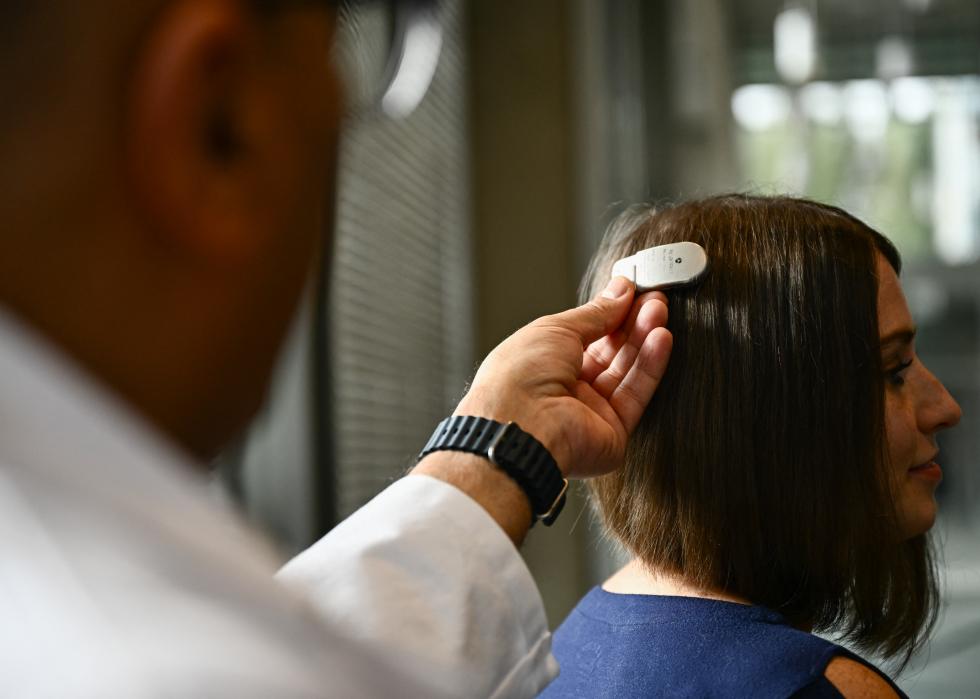
This story originally appeared on Medical Technology Schools and was produced and distributed in partnership with Stacker Studio.
How technology is bridging brains with computers
"It's all being done with my brain. If y'all can see the cursor moving around the screen, that's all me. It's pretty cool, huh?"
Those were the words of Noland Arbaugh, a man paralyzed from the shoulders down, who, with the help of a brain implant created by Neuralink, played chess on a laptop using only his mind. The company shared the moment with the world in a live stream on X in March.
Neuralink, a U.S. startup co-founded by Elon Musk, works on "brain-computing interfaces," known as BCI, which connect the brain to digital technology. Such devices come in different forms: Some are surgically implanted into peoples' heads, while others are noninvasive and sit outside of a person's body. In May 2023, the product received approval from the Food and Drug Administration for clinical trials, but it has yet to hit the market.
So how, exactly, does the technology work?
The chip transmits neural signals from a person's brain to a phone or computer that can then execute a function without tapping or swiping. In practice, electrical signals from the brain are converted to real-time data. In simpler terms, Arbaugh reported thinking of his intended movement and then watched it happen on screen.
In addition to changing the game for individuals with paralysis, this class of technology is helping researchers and medical professionals monitor brain activity to track unusual sleep patterns or early signs of epilepsy. Medical Technology Schools examined academic research and news reports to explore how the technology bridging brains with computers has evolved.

Researchers have been working at this for a long time
Countless scientists have attempted to understand how the brain affects the rest of the body. In the late 18th century, Italian physicist and physician Luigi and his partner Lucia Galvani discovered they could induce muscle contractions in frogs by applying electric shocks. The married pair from Bologna theorized they witnessed animal electricity and that the brain was vital in transmitting electrical fluid through nerves.
Over a century later, researchers honed their understanding of the electromagnetic signals sent from the brain. In 1929, German psychiatrist Hans Berger was the first to create an electrocorticogram recording of a surgery patient's brain waves, an inflection point in the evolution of neuroscience.
Brain wave research did not take off in earnest until the 1960s, with early experiments often focusing on monkeys. In 1973, Jacques Vidal, a computer science professor at the University of California, Los Angeles, published a paper coining the phrase "brain-computer interface" and laying the groundwork for the field.
In the early 1990s, Jonathan Wolpaw and a group of other researchers created early brain computer interfaces that let people move computer cursors from the center of a computer screen to the edges—with their minds.
By 1999, researchers figured out how to build a machine that let rats control a robotic arm well enough to get water, then used their "brain-derived signals" to control it. Studies that once may have read like science fiction now had a higher purpose: to learn about the potential to restore mobility in paralysis patients.
Neuralink's brain chip reflects the latest advancements in BCI technology. It works wirelessly, meaning people don't have a wire coming out of their heads as they did with past products. The brain chip also offers users more precise control compared to past devices. Arbaugh reported he could play Civilization VI, a popular computer game, for eight hours, only stopping because his brain implant needed recharging.
Other companies like Blackrock Neurotech and BrainGate are building similar devices.

Scientific advancement can be risky
As with any new technological frontier, research about BCI is fraught with ethical challenges. The science is still in its infancy, and human trials are limited.
Some critics cite the privacy concerns inherent in machines capable of scanning signals from a person's brain. Others say machines implanted in the brain can unexpectedly influence decision-making or moods. Should the future of brain computing interfaces provide, for example, enhanced cognition, it could create another digital divide—if the tech is only available to a few people, it may further entrench social inequality.
Safety and animal welfare concerns have clouded Neuralink in controversy. The company, which tested many of its products on monkeys, was investigated by the Department of Agriculture for animal welfare violations. Last year, Wired reported that as many as a dozen of Neuralink's test subjects died in captivity. Musk has denied that the monkeys died due to his company's experiments.
That same year, a special report from Reuters found that company employees were pressured to compromise safety to secure FDA approval quickly. Moreover, members of Congress have called upon the Securities and Exchange Commission to investigate whether Neuralink misled investors about the potential risks of its technology.
Professionals are split on how best to utilize BCI. The neurological community is keen on developing medical advancements to help individuals with neurological disorders and paralysis; some software and engineering "futurists" are eager to enhance human intelligence and augment everyone's abilities. As Musk put it, the ultimate goal of Neuralink is to "achieve symbiosis with artificial intelligence."
For Arbaugh, the technology hasn't created a total mind meld, but it's helping him push past former limitations: "Every day it seems like we're learning new stuff, and I just can't even describe how cool it is to be able to do this."
Story editing by Alizah Salario. Copy editing by Kristen Wegrzyn. Photo selection by Lacy Kerrick.



